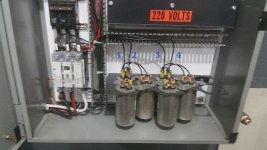I bought a used 35hp phase converter that came with a transformer (220v in and 220v out with taps for a 5% boost or cut to voltage). I guess this also fixes the wild leg problem too right?
Anyway the previous owner wired the transformer in directly and started the converter with the transformer connected, ran like this for years with no problems. I thought phase converters had to be started without any load connected? Should i install a disconnect and only connect the transformer once the converter is up to speed? This should make for less load on the system when starting right? Or should i just use it the same way it has been running for years?
Anyway the previous owner wired the transformer in directly and started the converter with the transformer connected, ran like this for years with no problems. I thought phase converters had to be started without any load connected? Should i install a disconnect and only connect the transformer once the converter is up to speed? This should make for less load on the system when starting right? Or should i just use it the same way it has been running for years?





